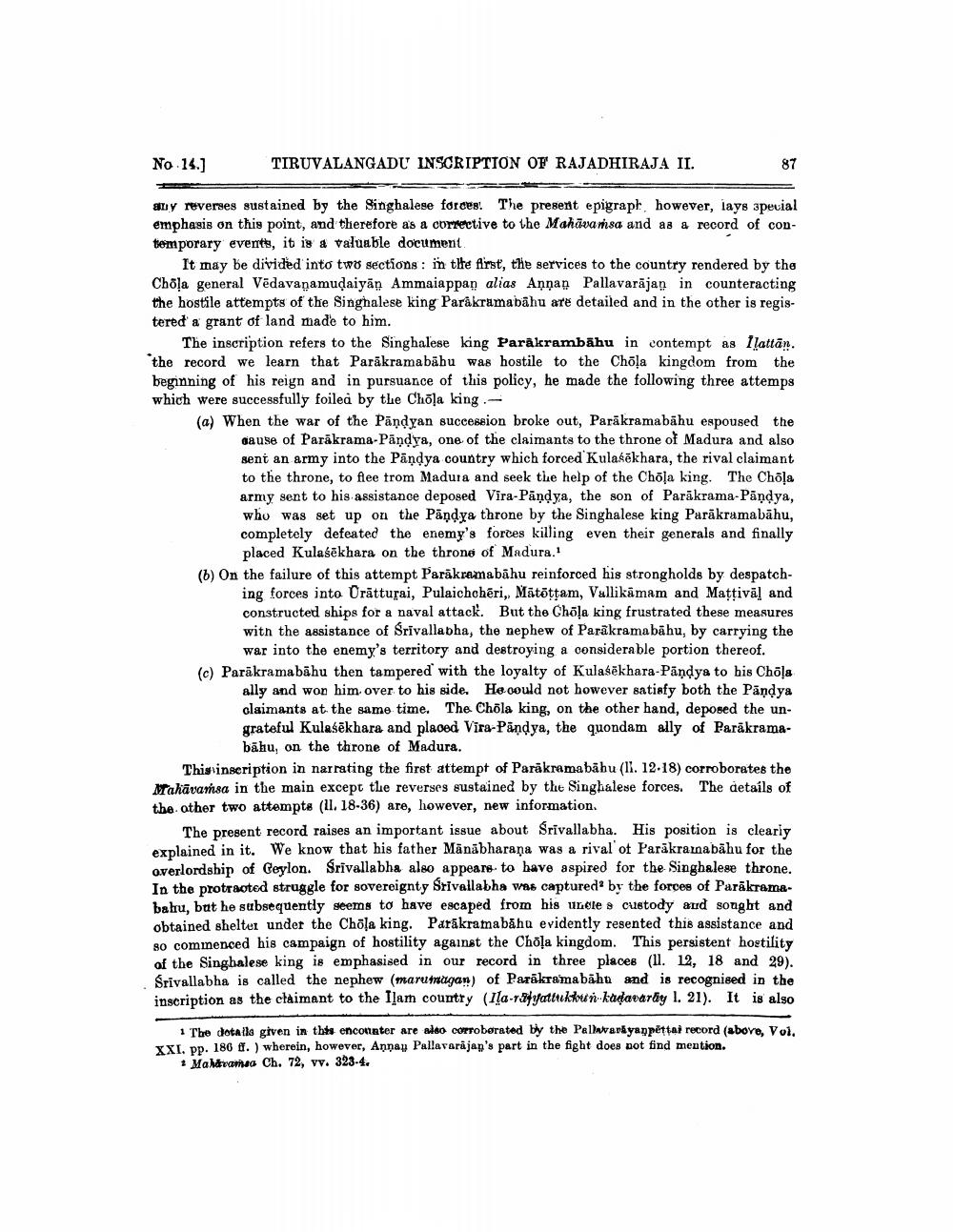________________
No. 14.]
TIRUVALANGADU INSCRIPTION OF RAJADHIRAJA II.
87
any reverses sustained by the Singhalese forces. The present epigraph, however, lays special emphasis on this point, and therefore as a corrective to the Mahāvamsa and as a record of contemporary events, it is a valuable document
It may be divided into two sections: in the first, the services to the country rendered by the Chola general Vēdavanamudaiyān Ammaiappan alias Annan Pallavarājan in counteracting the hostile attempts of the Singhalese king Parakramabāhu are detailed and in the other is registered a grant of land made to him.
The inscription refers to the Singhalese king Parakrambāhu in contempt as flattān. the record we learn that Parākramabāhu was hostile to the Chõļa kingdom from the beginning of his reign and in pursuance of this policy, he made the following three attemps which were successfully foiled by the Chola king - (a) When the war of the Pandyan succession broke out, Parākramabāhu espoused the
da use of Parākrama-Pandya, one of the claimants to the throne of Madura and also sent an army into the Pandya country which forced Kulasēkhara, the rival claimant to the throne, to flee from Madura and seek the help of the Chola king. The Chola army sent to his assistance deposed Vira-Pāņdya, the son of Parākrama-Pāņdya, who was set up on the Pandya throne by the Singhalese king Parākramabāhu, completely defeated the enemy's forces killing even their generals and finally
placed Kulasekhara on the throne of Madura.' (b) On the failure of this attempt Parākramabāhu reinforced his strongholds by despatch
ing forces into Oratturai, Pulaichchéri, Mātottam, Vallikāmam and Mattival and constructed ships for a naval attack. But the Chāļa king frustrated these measures with the assistance of Srivallabha, the nephew of Parakramabāhu, by carrying the
war into the enemy's territory and destroying a considerable portion thereof. (c) Parākramabāhu then tampered with the loyalty of Kulasēkhara-Pāņdye to his Chõļa
ally and won him over to his side. He could not however satisfy both the Pāņdya claimants at the same time. The Chola king, on the other hand, deposed the ungrateful Kulasēkhara and placed Vira-Pandya, the quondam ally of Parikrama
bāhu, on the throne of Madura. This inscription in narrating the first attempt of Parakramabahu (11. 12.18) corroborates the Mahāvansa in the main except the reverses sustained by the Singhalese forces. The details of the other two attempts (II. 18-36) are, however, new information
The present record raises an important issue about Srivallabha. His position is clearly explained in it. We know that his father Mānābharaṇa was a rival of Paräkrainabāhu for the overlordship of Geylon. Srivallabha also appears to have aspired for the Singhalese throne. In the protracted struggle for sovereignty Srivallabha was captured by the forces of Parakramebahu, but he subsequently seems to have escaped from his uncle custody and sought and obtained shelter under the Chöļa king. Parākramabāhu evidently resented this assistance and so commenced his campaign of hostility against the Chöļa kingdom. This persistent hostility of the Singhalese king is emphasised in our record in three places (11. 12, 18 and 29). Srivallabha is called the nephew (marumagan) of Parākramabāhu and is recognised in the inscription as the claimant to the Ilam country (Ila-ayatttikhun kadavarly 1. 21). It is also
1 The details given in this encounter are also corroborated by the Pellavarayanpettai record (above, Voi, XXI. pp. 180.) wherein, however, Annay Pallavarajan's part in the fight does not find mention.
Maharamsa Ch. 72, vv. 323-4.




